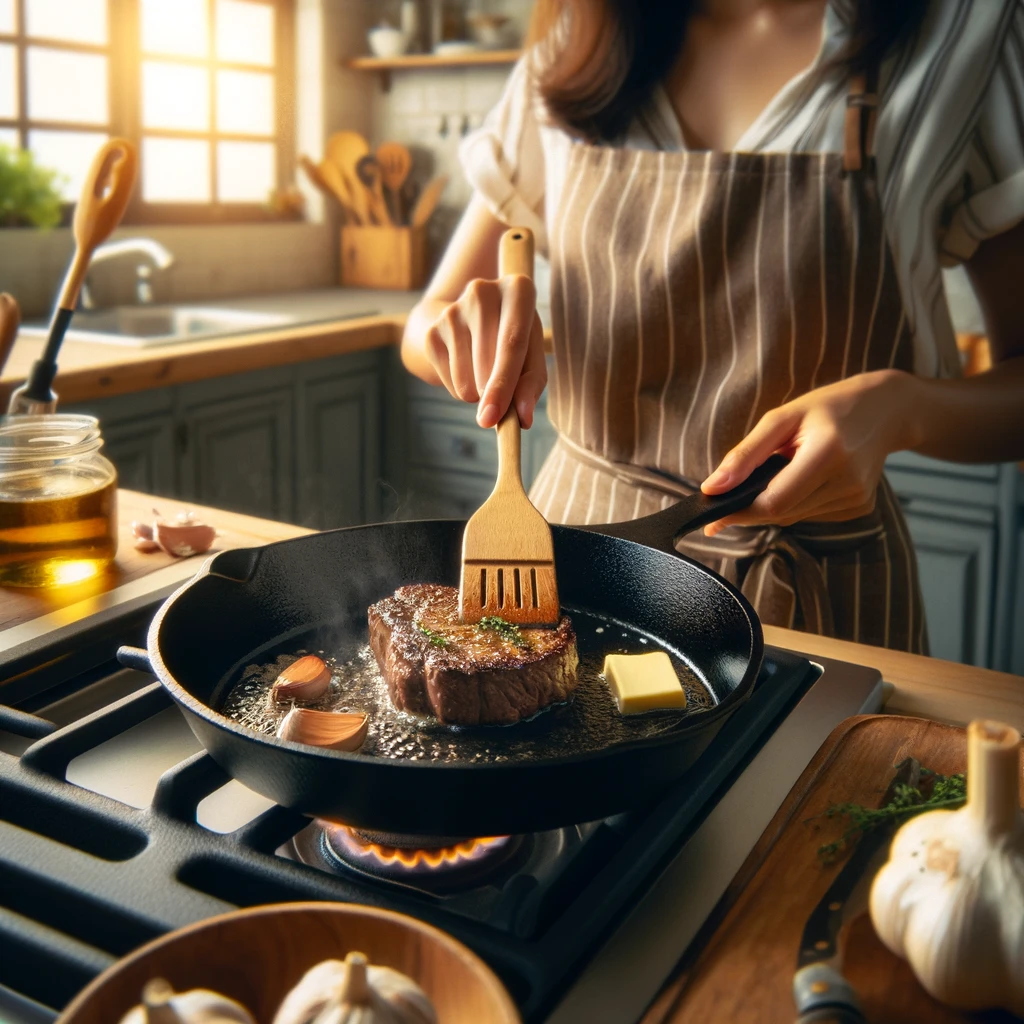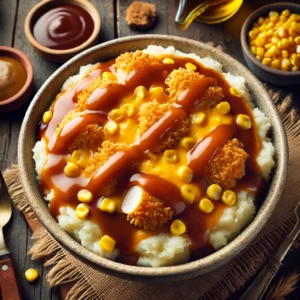This post may include affiliate links which means I may receive a commission from purchases made through links. I will only recommend products I have personally used. Learn more on my private policy page.

If you’re a steak lover like me, you know that nothing beats a perfectly cooked tenderloin steak. Learning how to Cook Tenderloin Steak is a skill that every meat lover should learn.
This cut of meat is not only tender and flavorful, but it also has a reputation for being a bit tricky to cook.
However, with the right techniques and a little practice, you can master the art of cooking tenderloin steak at home.
In this blog post, I will share with you my step-by-step recipe for cooking tenderloin steak perfectly every time.
Ingredients You’ll Need for the Perfect Steak
Crafting the ultimate tenderloin steak begins with gathering the right ingredients, a crucial step that sets the foundation for your culinary masterpiece.
High-Quality Tenderloin Steaks
For this endeavor, you’ll want to ensure you have 2 high-quality tenderloin steaks, each about 1 inch in thickness.
This cut’s natural tenderness and flavor make it a prime choice for a memorable meal.
Seasoning
Next, you’ll need salt and pepper for seasoning.
The simplicity of these seasonings allows the natural taste of the steak to shine through, creating a perfect balance of flavors.
Olive Oil
Additionally, olive oil is essential for cooking, providing the necessary fat to sear the steak to perfection without sticking to your pan or grill.
Optional Ingredients

For those looking to elevate their steak further, consider having garlic, butter, and fresh herbs on hand.
These optional ingredients can be used to create a finishing touch that enriches the steak’s flavor profile, adding layers of complexity and aroma that will tantalize the taste buds.
Remember, the quality of your ingredients directly influences the final outcome of your dish.
Selecting premium tenderloin steaks and fresh, high-grade seasonings and accompaniments will ensure that your effort in the kitchen pays off with every succulent bite.
With these key ingredients ready, you’re well on your way to cooking a tenderloin steak that’s bound to impress.
Preparation for How to Cook Tenderloin Steak
The journey to a succulent tenderloin steak starts well before it ever hits the pan or grill.
- After selecting your premium cuts, the initial and pivotal step is to let them sit out until they reach room temperature, a process that typically takes around 30 minutes.
This is not a step to be overlooked, as it ensures that your steak cooks more evenly, preventing those all-too-common scenarios where the outside is overdone while the inside remains too rare for your liking.
2. Next up is seasoning, a simple yet crucial stage. With salt and pepper at your disposal, season both sides of each steak generously.
This not only enhances the natural flavors of the meat but also aids in creating that desirable, crisp crust that steak aficionados cherish.
3. Don’t be shy with the seasoning; remember, a portion of it will inevitably be lost to the cooking process.
4. For those aspiring to elevate their culinary game, consider lightly brushing the steak with olive oil before seasoning.
This not only prevents sticking but can also help the seasoning adhere better to the meat. The addition of olive oil introduces an extra layer of flavor that complements the natural taste of the steak.
5. While it might seem tempting to start cooking immediately after seasoning, taking a moment to prepare your cooking surface—be it a skillet or grill—and your additional ingredients (if using) like garlic, butter, and herbs, will streamline the cooking process.
6. Having everything ready and at arm’s reach ensures a smooth and enjoyable cooking experience, setting the stage for a perfectly cooked tenderloin steak.
Choosing the Right Cooking Equipment
Selecting the appropriate cooking equipment is a pivotal step in ensuring your tenderloin steak is cooked to perfection.
The choice between stove-top cooking and grilling largely depends on your preference and the tools at your disposal.
For those inclined towards stove-top cooking, a heavy-bottomed skillet or a cast-iron pan is indispensable.
These pans distribute heat evenly and maintain a consistent temperature, which is crucial for achieving that perfectly seared crust without overcooking the interior.
A cast-iron skillet, in particular, excels in retaining high heat and can seamlessly transition from stovetop to oven, offering versatility in your cooking methods.
On the other hand, if grilling is your preferred method, ensuring your grill is in prime condition is key.
A clean grill with grates that have been preheated to high heat is vital for a well-grilled steak.
The intense heat from a grill chars the steak‘s exterior, locking in juices and flavor, and imparting a distinct smokiness that’s hard to replicate on a stove.
Whether you’re using a charcoal grill for that added smoky flavor or a gas grill for convenience and control, the high heat and direct flame are perfect for tenderloin steaks.
No matter your choice, preheating your cooking surface is a non-negotiable step.
A sufficiently heated skillet or grill ensures your steak starts cooking the moment it touches the surface, creating that desired sizzle and starting the Maillard reaction process, which is responsible for the delicious crust that steak lovers crave.
This crucial step cannot be overstated for achieving the perfect tenderloin steak.
How to Cook Your Tenderloin Steak on the Stove

Begin by heating your skillet over medium-high heat, opting for a heavy-bottomed skillet or cast-iron pan to ensure even heat distribution.
As the pan heats, lightly coat the bottom with olive oil to prevent sticking and allow for a seamless sear.
Once the skillet has reached the desired temperature, evidenced by the oil shimmering but not smoking, carefully place your seasoned tenderloin steaks in the pan.
The key to a beautifully cooked steak is not to move it around too much. Allow the steak to sear undisturbed for about 3-4 minutes.
This process creates a flavorful crust that steak enthusiasts adore. After the initial sear, use tongs to flip the steak gently. If the steak releases from the pan without resistance, it’s ready to be flipped.
Continue to cook for an additional 3-4 minutes for medium-rare, adjusting the time slightly if you’re aiming for medium or well-done steaks.
Throughout the cooking process, you may choose to add a tablespoon of butter, some crushed garlic, and fresh herbs to the skillet, basting the steak with this aromatic mixture to infuse it with additional flavors.
Remember, the exact cooking time will vary based on the steak’s thickness and your desired level of doneness, so using a meat thermometer can ensure precision.
Once cooked to your liking, remove the steak from the skillet and let it rest on a cutting board or plate, tented loosely with foil, to allow the juices to redistribute, ensuring every bite is as delicious as the first.
Mastering the Art of Grilling Tenderloin Steak

When you’re set on grilling your tenderloin steak, the process begins with ensuring your grill is preheated to a high temperature.
This is crucial for achieving that sought-after char and sear that grilling is famous for.
Brush your steaks lightly with olive oil before placing them on the grill; this helps prevent sticking and promotes an even cook.
Position the steaks on the hottest part of the grill and let them cook undisturbed for about 4-5 minutes on each side if you’re aiming for a medium-rare finish.
For those who prefer their steak medium, adjust the time to approximately 6-7 minutes per side, and for a well-done finish, aim for 8-9 minutes per side.
While grilling, resist the urge to press down on the steaks with your spatula or flip them too frequently.
This can release the precious juices that keep the steak moist and flavorful.
Instead, allow the high heat to do its work, creating a crisp, caramelized exterior while the inside remains tender and juicy.
Should you decide to add an extra layer of flavor, consider throwing some wood chips designed for grilling into the mix or placing herbs directly on the coals if using a charcoal grill.
These can impart a subtle smokiness or herby freshness to the meat that enhances its natural flavors.
Grilling tenderloin steak is an art that combines high heat, timing, and patience.
By adhering to these principles, you’ll achieve a steak that’s charred on the outside, tender and juicy on the inside, and packed with the robust flavors that only grilling can offer.
The Importance of Resting Your Steak
One often underestimated step in the journey to achieving the perfect tenderloin steak is the resting period after cooking.
This crucial process is essential for a reason: it allows the steak to reabsorb the juices that have been mobilized by the heat of cooking.
When a steak is exposed to high temperatures, the juices within it are pushed out towards the surface, and without a proper rest, these flavorful juices can end up on your cutting board instead of in your steak.
To properly rest your steak, simply remove it from the heat source—be it a skillet or a grill—and place it on a warm plate or cutting board.
Cover it loosely with aluminum foil to keep it warm without causing it to sweat, which could result in a loss of crispiness on the exterior.
The ideal resting time ranges from 5 to 10 minutes, depending on the size and thickness of your steak.
This might seem like a small detail, but it’s a period that can make all the difference in the world in terms of the final texture and juiciness of your steak.
This pause in the cooking process gives the fibers within the steak time to relax and redistribute the juices evenly throughout the meat.
Cutting into a steak too soon after it’s removed from heat will cause those precious, flavorful juices to spill out, leaving the meat drier and less flavorful.
By embracing the importance of this resting phase, you’re ensuring that each bite of your tenderloin steak is as succulent and tender as possible, enhancing the overall dining experience.
Tips for Slicing and Serving Your Steak
When you’re ready to slice into your beautifully cooked tenderloin steak, the way you cut it can significantly affect the tenderness and presentation of each bite.
Always slice your steak against the grain. This means identifying the direction of the muscle fibers and cutting across them, rather than parallel.
This technique shortens the fibers, making the steak easier to chew and enhancing its tenderness.
As for serving your masterpiece, presentation is key. Consider placing your tenderloin steak on a warm plate to maintain its temperature.
Surround it with complementary side dishes that not only add color but also balance the meal’s flavors.
Popular choices include a dollop of creamy mashed potatoes, which can be infused with garlic or herbs for added flavor, a side of vibrant green asparagus or crispy roasted Brussels sprouts for a touch of freshness, or a simple mixed greens salad dressed with vinaigrette.
To make your tenderloin steak dinner even more memorable, consider adding a final touch with a garnish.
A sprinkle of coarse sea salt can enhance the steak’s flavor, while a few sprigs of fresh thyme or rosemary add both color and a fragrant aroma.
If you’ve prepared any additional sauces or compound butters, serve them on the side or lightly drizzled over the steak to allow everyone to customize their dish to their taste preferences.
These tips for slicing and serving your tenderloin steak will ensure that your dish not only tastes fantastic but also looks inviting, promising a dining experience that’s as pleasing to the eye as it is to the palate.
Additional Seasonings and Sauces to Elevate Your Steak
While the natural flavors of a high-quality tenderloin steak can stand proudly on their own, exploring additional seasonings and sauces can transport your culinary creation to new heights.
A well-chosen enhancement not only complements the steak’s inherent richness but can also introduce a delightful contrast or an unexpected burst of flavor that makes each bite even more memorable.
Consider a dollop of homemade garlic butter melting atop your freshly grilled or seared steak, infusing it with a velvety richness and a gentle hint of garlic that pairs beautifully with the tender meat.
For a more robust flavor profile, a sprinkle of freshly chopped herbs such as rosemary, thyme, or parsley can add a refreshing aromatic quality that cuts through the richness of the steak.
For those who enjoy a tangy counterpoint to the savory depth of the steak, a drizzle of balsamic reduction can offer a sweet and sour experience that tantalizes the palate.
Additionally, creating a quick compound butter with blue cheese and chives provides a creamy texture and a sharp, pungent kick that is sure to impress.
Don’t overlook the power of a simple seasoning blend either.
A mix of sea salt, cracked black pepper, and a hint of smoked paprika can elevate the natural flavors of your steak without overwhelming its delicate taste.
Experimenting with these additions allows you to tailor your tenderloin steak to your personal preferences or to the theme of your meal, making each steak an opportunity for culinary creativity and discovery.
Troubleshooting Common Steak-Cooking Mistakes
Navigating through common steak-cooking errors can enhance your culinary experience and ensure your tenderloin steak turns out perfect every time.
One frequent mistake is not allowing the steak to reach room temperature before cooking, which can lead to uneven cooking.
Always take your steak out of the fridge about 30 minutes prior to cooking. Over-seasoning is another pitfall; while it’s crucial to season generously, going overboard can overpower the steak’s natural flavors.
Aim for a balanced application of salt and pepper. Additionally, using a pan that’s not hot enough can prevent that desirable sear, so be sure your cooking surface is adequately preheated.
If you find your steak sticking to the pan or grill, it’s likely because it hasn’t seared long enough on that side. Give it time, and it will release naturally once a proper crust has formed.
Lastly, cutting into the steak too soon after cooking can result in loss of juices, leading to a dryer steak. Ensure you rest your steak for 5 to 10 minutes to allow juices to redistribute.
By keeping these pointers in mind, you’ll avoid common missteps and achieve a delectably tender result.
Pairing Wine with Tenderloin Steak

Selecting the perfect wine to accompany your tenderloin steak elevates the meal from simply delicious to truly memorable.
A full-bodied red wine is typically the go-to choice for its ability to complement the rich, savory flavors of the steak.
Cabernet Sauvignon
Cabernet Sauvignon, with its deep fruit flavors and hints of spice, makes an excellent partner, enhancing the meat’s natural succulence.
Merlot
Merlot is another splendid option, offering a softer, more velvety texture and slightly sweeter notes that contrast beautifully with the steak’s savory depth.
Shiraz
For a more adventurous pairing, a Syrah or Shiraz can introduce a peppery kick that mirrors the steak’s seasoning, creating a harmonious blend of flavors.
When choosing your wine, consider the steak’s preparation and any additional seasonings or sauces used, as these can influence the best pairing.
A well-chosen wine not only complements the meal but also turns the dining experience into a special occasion, making each bite of tenderloin steak and each sip of wine a moment to savor.
Related Articles:
Conquer the Grill: How to Grill Filet Mignon Perfectly Every Time
Soft Shell Crab 101: Buy, Clean, Cook, and Eat Like a Pro
As an Amazon Associate, I earn commission from qualifying purchases.




